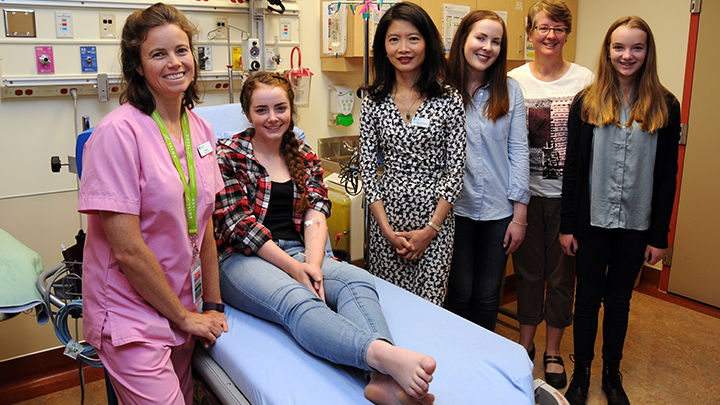
September 13, 2016
Story by Greg Harris; Photo by Paul Rotzinger
CALGARY — For the past seven years, 17-year-old Kendra MacLean has visited Alberta Children’s Hospital here twice a year, gulped back an extra-sugary concoction, then had an intravenous line inserted for blood sampling over a couple of hours.
You could say the Grade 12 student has helped bring diabetes research to a whole new level.
Kendra’s contributions have led to the development of a new staging classification system that defines levels in the progression of Type 1 diabetes — from the earliest responses of the body’s immune system, through to clinical diagnosis.
“What I’ve been doing in the research study once a year is minor, compared to what my sister goes through every day while living with diabetes,” Kendra says of her older sister, Laura, 19, who was diagnosed with Type 1 diabetes when she was six.
“If this in some way can help other kids in the future, then I’m happy to do it.”
Kendra and 150,000 other study participants from around the world who have close relatives with diabetes are helping to lay the groundwork for further research aimed at preventing Type 1 diabetes.
Researchers in both Calgary and Edmonton are part of an international network of Type 1 diabetes researchers called TrialNet, which is funded primarily by the National Institutes of Health in the United States.
Dr Carol Huang, an endocrinologist who leads the Calgary arm of the diabetes staging study, says a better understanding of disease progression is a significant advancement.
“Children are usually only diagnosed with Type 1 diabetes after they’ve shown up in emergency departments with clinical symptoms of diabetes,” says Dr. Huang. “By that point all we can do is manage the illness. But if we can detect its development much earlier, we may be able to delay, or one day even prevent disease progression.”
The new staging classification system (see factbox below) has been recommended by the American Diabetes Association, the Juvenile Diabetes Research Foundation and the Endocrine Society. Dr. Huang says that for now, it’s only being used in the research context.
Type 1 diabetes is an autoimmune disease in which the immune system destroys the beta cells in the pancreas, which produce insulin. People with Type 1 diabetes need to take insulin through a needle several times each day so their bodies can properly use carbohydrates, or sugars, as an energy source.
Symptoms of Type 1 diabetes include frequent urination, excessive thirst, fatigue and weight loss. Over time, high blood sugar levels can cause other serious complications, such as kidney, nerve and eye damage.
In Type 2 diabetes, the body still produces insulin, but the body has difficulty processing it correctly. Exercising, eating a balanced diet and maintaining a healthy weight all help prevent the onset of Type 2 diabetes. Type 2 is usually an adult illness, although it can also occur in children.
Alberta Children’s Hospital Research Coordinator Claire Gougeon says that in the staging study, family members of people with diabetes are first tested for diabetes-related autoantibodies, then, if need be, they undergo a glucose tolerance test.
“Autoantibodies are proteins that are made by the body’s immune system. If these proteins are present, it could mean that cells in the pancreas that produce insulin are damaged. Certain kinds of antibodies can be found in the blood years before Type 1 diabetes occurs.”
In Kendra’s case, autoantibodies have appeared, then disappeared, then reappeared again as the years have gone on. She’s now currently involved in a second study on diabetes prevention that’s looking at whether a drug used for arthritis can prevent or delay the onset of diabetes.
The youngest MacLean daughter, 12-year-old Jensen, has also been involved in the research, but because she hasn’t tested positive for any antibodies, she only undergoes a regular blood draw (no intravenous line) once a year and doesn’t have to drink the sugary beverage in advance.
For her part Laura applauds Kendra’s contributions to medical science.
“Although the studies Kendra's participating in won't personally benefit me, I think it's great that she's gotten involved and is doing something that might help future generations of kids. If doctors could one day figure out how to prevent the onset of diabetes it would be an incredible breakthrough.”
To find out more on how to get involved in ongoing diabetes research at Alberta Children’s Hospital, please visit https://wcm.ucalgary.ca/achdiabetes/research, or contact Claire Gougeon at 403-955-8866 or email Claire.Gougeon@ahs.ca

Registered Nurse Claire Gougeon, Alberta Children’s Hospital Research Coordinator, left, shares a moment with diabetes study participant Kendra MacLean, 17, Dr. Carol Huang, endocrinologist & lead for the Calgary arm of the TrialNet study, sister Laura MacLean, 19, their mother Corinne MacLean, and sister Jensen MacLean, 12.
According to the new staging classification system endorsed by the Juvenile Diabetes Research Foundation, the American Diabetes Association and the Endocrine Society, Type 1 diabetes can now be most accurately understood as a disease that progresses in three distinct stages.
Stage 1 is the start of Type 1 diabetes. Individuals test positive for two or more diabetes-related autoantibodies. The immune system has already begun attacking the insulin-producing beta cells, although there are no symptoms and blood sugar remains normal.
Stage 2, like stage 1, includes individuals who have two or more diabetes-related autoantibodies, but now, blood sugar levels have become abnormal due to increasing loss of beta cells. There are still no symptoms.
Stage 3 is when clinical diagnosis has typically taken place. By this time, there is significant beta cell loss and individuals generally show common symptoms of Type 1 diabetes, which include frequent urination, excessive thirst, weight loss, and fatigue.